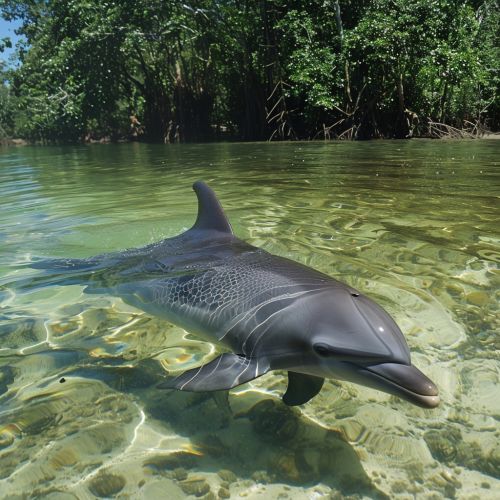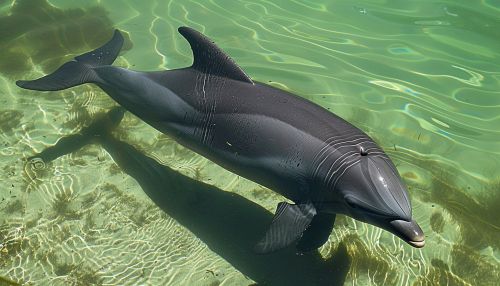Amazon river dolphin: Difference between revisions
(Created page with "== Introduction == The Amazon river dolphin (Inia geoffrensis), also known as the boto, bufeo, or pink river dolphin, is a freshwater cetacean found in the Amazon and Orinoco river basins. It is notable for its distinctive pink coloration, which varies among individuals and can change with age and environmental conditions. This species is one of the few river dolphins and is adapted to the unique conditions of its habitat. == Taxonomy and Evolution == The Amazon river...") |
No edit summary |
||
| Line 11: | Line 11: | ||
Amazon river dolphins are characterized by their robust bodies, long snouts, and flexible necks. Adults can reach lengths of up to 2.5 meters and weigh up to 185 kilograms. Their coloration ranges from gray to pink, with older males typically exhibiting the most pronounced pink hues. This coloration is thought to be influenced by capillary placement near the skin's surface and scar tissue from social interactions. | Amazon river dolphins are characterized by their robust bodies, long snouts, and flexible necks. Adults can reach lengths of up to 2.5 meters and weigh up to 185 kilograms. Their coloration ranges from gray to pink, with older males typically exhibiting the most pronounced pink hues. This coloration is thought to be influenced by capillary placement near the skin's surface and scar tissue from social interactions. | ||
[[Image:Detail-91595.jpg|thumb|center|Amazon river dolphin swimming in clear water.|class=only_on_mobile]] | |||
[[Image:Detail-91596.jpg|thumb|center|Amazon river dolphin swimming in clear water.|class=only_on_desktop]] | |||
== Habitat and Distribution == | == Habitat and Distribution == | ||
Latest revision as of 13:21, 20 June 2024
Introduction
The Amazon river dolphin (Inia geoffrensis), also known as the boto, bufeo, or pink river dolphin, is a freshwater cetacean found in the Amazon and Orinoco river basins. It is notable for its distinctive pink coloration, which varies among individuals and can change with age and environmental conditions. This species is one of the few river dolphins and is adapted to the unique conditions of its habitat.
Taxonomy and Evolution
The Amazon river dolphin belongs to the family Iniidae and is the only species in the genus Inia. There are three recognized subspecies: Inia geoffrensis geoffrensis, Inia geoffrensis boliviensis, and Inia geoffrensis humboldtiana. The evolutionary history of the Amazon river dolphin is complex, with genetic studies suggesting that it diverged from other cetaceans around 15 million years ago. This divergence is believed to have been driven by the uplift of the Andes, which significantly altered the river systems in South America.
Physical Characteristics
Amazon river dolphins are characterized by their robust bodies, long snouts, and flexible necks. Adults can reach lengths of up to 2.5 meters and weigh up to 185 kilograms. Their coloration ranges from gray to pink, with older males typically exhibiting the most pronounced pink hues. This coloration is thought to be influenced by capillary placement near the skin's surface and scar tissue from social interactions.


Habitat and Distribution
The Amazon river dolphin inhabits the freshwater river systems of the Amazon and Orinoco basins, spanning several countries including Brazil, Peru, Colombia, Venezuela, Ecuador, and Bolivia. These dolphins are highly adapted to their environment, thriving in both clear and murky waters, and are often found in flooded forests during the rainy season. Their distribution is influenced by water levels, with individuals moving into smaller tributaries and floodplains during high water periods.
Behavior and Social Structure
Amazon river dolphins are generally solitary, though they can be found in small groups, particularly mothers with calves. They exhibit a range of behaviors, including echolocation, which they use to navigate and hunt in the often turbid waters of their habitat. Their diet consists primarily of fish, but they also consume crustaceans and small turtles. Social interactions among these dolphins can be complex, involving vocalizations, body postures, and physical contact.
Reproduction and Lifespan
The reproductive cycle of the Amazon river dolphin is not well-documented, but it is believed that mating occurs year-round, with a peak during the high water season. Females give birth to a single calf after a gestation period of approximately 11 months. Calves are dependent on their mothers for up to two years, during which time they learn essential survival skills. The lifespan of these dolphins in the wild is estimated to be around 30 years, though this can vary based on environmental conditions and human impacts.
Conservation Status
The Amazon river dolphin is currently classified as Endangered by the International Union for Conservation of Nature (IUCN). Major threats to their survival include habitat degradation, pollution, and accidental capture in fishing gear. Additionally, the construction of dams and other infrastructure projects poses significant risks by altering river flow and fragmenting populations. Conservation efforts are focused on habitat protection, pollution control, and the establishment of protected areas.
Cultural Significance
In local folklore, the Amazon river dolphin holds a special place, often associated with myths and legends. One common belief is that these dolphins can transform into handsome young men, known as "boto encantado," who come ashore to seduce women. These cultural narratives highlight the deep connection between the river dolphins and the indigenous peoples of the Amazon basin.
Research and Studies
Ongoing research on the Amazon river dolphin includes studies on their behavior, genetics, and ecology. Researchers use various methods, such as biotelemetry and acoustic monitoring, to gather data on their movements and interactions. These studies are crucial for developing effective conservation strategies and understanding the broader ecological role of these dolphins in their freshwater environments.
